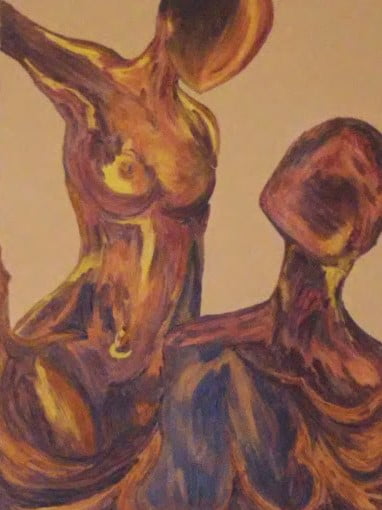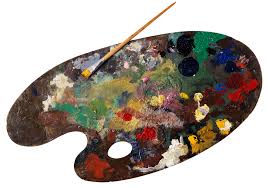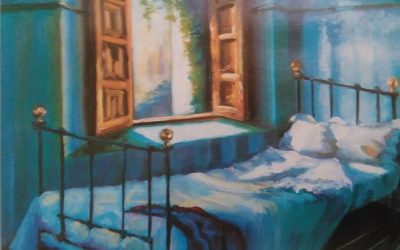Painting with oil colours can seem very demanding for most beginners but it is also a technique I find to be most fulfilling and satisfying. Because oil colours take a long time to fully dry oil colour painting allows you to correct mistakes easily so just relax get all the materials needed and you can begin.
Workspace
First of all, make sure that your workspace is bright and properly ventilated. Oil colours and solvents for oil colours can give very toxic fumes and it can be very health threatening using them in closed space.
Organize your workspace properly so that nothing is distracting you while you work, put up your easel or table away from direct sunlight get all the supplies needed and you are ready to start.
All you need for the beginning are a few primary colours such as titanium white, cadmium yellow, ocher yellow, cadmium red, ultramarine blue,

Basic Materials
You can purchase already primed canvas but still apply at least one layer of gesso on it because you never know if it has been properly primmed with the right amount of gesso.
Start with a small surface to paint on it will be much easier to control and achieve the effect you want to.
Later when you get to know the process of mixing the colours and feel more relaxed about oil painting you can start to paint on bigger surfaces.
In the beginning, you will need just a few different brushes until you find your own style of painting and realize which ones do you use the most.
For palette, you can purchase one in an art store or just use a glass from some old picture frame with grey paper under it, grey colour of the paper will make all the colours you use look much brighter and it will be easier for you to mix them to get the one you need.
You will also need a palette knife for mixing the colours, rag which can be just a piece of clean old clothes something that you don’t need to wash just throw away after it gets too dirty to use, you can always use paper towels but I wouldn’t recommend that because even if they are of high-quality small pieces of paper could get on the bristles and get into the paint when you use the brush again, also you will need a solvent for oil colours such as turpentine or
Starting To Paint
Now that you got everything prepared and feel comfortable in your work environment its time to start painting. Get the surface you want to paint on whether its primed canvas, paper, or a board and start with a sketch.
The best way to sketch is using a light very thin layer of oil colour which you get by mixing oil colour with turpentine or odourless mineral spirits.
Don’t add oil to the colour for the first layer because it dries very slow and it can cause the paint to crack when adding the next thicker layer on it, the second layer of oil colour you will mix with turpentine or odourless mineral spirits and with linseed oil.
For sketching, you can also use a hard pencil and you can create your sketch on a drawing paper or directly on the surface you will paint on.
Make sure you create a very light sketch of the subject you desire to paint if you do it directly on the canvas, you don’t want it to mix with your oils and change their colour.
The oil colours drying period is very long from a month up to a year, so you do not need to rush it there is always room for correcting your errors.
Use a limited painting palette for the first few paintings, that will be much less confusing and it will help you learn how to mix oil colours and feel what technique suits you the best.
Remember to always paint thick over thin and slow drying layers over fast drying layers. Doing so will prevent colour from cracking and flacking.
Once you finish the painting and it is properly dry you should varnish it in order to protect the colour from changing and getting darker over time and in order to give the colours a nice bright and fresh look.
Don’t forget to properly clean the brushes and palette of any oil colour so you would be able to use them again.
If you don’t feel comfortable sketching you can always just start painting directly on the canvas with no sketch, nothing wrong with that.
Sometimes when I paint I start off with one thing and end up painting something completely different, just go where my mind takes me during the process so it doesn’t look even similar to what I was sketching or planning to do when I first set in front of my easel.
There is no right or wrong when it comes to creating art, as long as you enjoy making it that’s all that matters.
Don’t be too harsh on yourself, in the beginning, give yourself time to get to know the mediums you’re using, experiment and before you know it you will be creating little masterpieces. You don’t have to make your art meet any one’s criteria but yours.
I hope I managed to help you understand the technical parts of oil painting and if there is anything that is still unclear to you feel free to leave me a question I will be more than happy to answer and help you feel comfortable on this wonderful journey you’re about to begin.





0 Comments